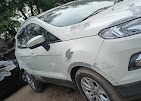When a vehicle is involved in an accident the repair process in a workshop is critical to restoring it to its pre-accident condition.
This process can be intricate, involving multiple steps and specialized expertise. Here’s a detailed look at how accident car repairs are typically handled in an auto repair workshop:

1. Initial Inspection and Assessment
a. Arrival and Documentation: When a car arrives at the workshop, the first step is to document the damage thoroughly. This usually involves taking photographs and detailed notes on the condition of the vehicle. The car’s VIN (Vehicle Identification Number) and other relevant details are recorded.
b. Preliminary Inspection: A certified technician performs an initial inspection to assess visible damage. This inspection includes checking the exterior for dents, scratches, and misalignment, as well as evaluating the interior and mechanical components for any issues. The goal is to identify both visible and potential hidden damages.
2. Establishing the Repair Plan
a. Insurance Coordination: If the repair costs are covered by insurance, the workshop will work with the insurance company to get an estimate approved. This involves providing detailed reports and cost estimates for the required repairs.
b. Repair Plan Development: Based on the inspection, the workshop develops a comprehensive repair plan. This plan outlines which parts need to be repaired or replaced, the type of repairs required, and the estimated time and cost for each task.

3. Disassembly and Detailed Inspection
a. Disassembly: To assess the full extent of the damage after the Accident the vehicle may need to be partially or fully disassembled. This involves removing damaged panels, bumpers, lights, and sometimes interior components to expose underlying damage.
b. Detailed Inspection: With the vehicle disassembled, technicians conduct a more thorough inspection. This includes checking the frame for structural damage, evaluating the condition of mechanical components, and identifying any issues that were not visible during the initial inspection.
4. Repair and Replacement
a. Structural Repairs: For vehicles with frame damage, workshops use specialized equipment like frame machines to realign and straighten the vehicle’s frame. This is crucial for ensuring that the car handles properly and remains safe to drive.
b. Mechanical Repairs: Any damaged mechanical components, such as the engine, transmission, or suspension parts, are repaired or replaced as needed. Technicians ensure that all mechanical systems are functioning correctly before proceeding with other repairs.
c. Body Repairs: Dented panels and damaged body parts are repaired or replaced. This involves using techniques such as pulling, filling, and sanding to restore the car’s exterior. For severe damage, parts like fenders, doors, or bumpers may be replaced entirely.
d. Painting: After body repairs, the vehicle is repainted. This process includes sanding the repaired areas, applying primer, painting, and then applying a clear coat. The goal is to match the original paint and finish seamlessly.
5. Reassembly and Final Checks
a. Reassembly: Once repairs are completed and the paint has dried, the vehicle is reassembled. This includes reinstalling any removed parts and ensuring that everything is correctly aligned and functioning.
b. Quality Control: Technicians perform a comprehensive quality control check. This involves inspecting the vehicle for any issues, such as misaligned panels, inconsistent paint, or mechanical problems. They also test drive the car to ensure that it operates correctly and handles as expected.
6. Completion and Delivery
a. Final Inspection: A final inspection is conducted to ensure that all repairs meet industry standards and that the vehicle is safe to drive. Any additional adjustments are made as necessary.
b. Documentation and Delivery: The vehicle’s repair documentation, including invoices and warranties, is prepared for the owner. The car is then cleaned and returned to the owner. The workshop provides a summary of the repairs and any recommendations for future maintenance.
7. Post-Repair Considerations
a. Follow-Up: Some workshops offer follow-up services to address any issues that may arise after the vehicle is returned. This helps ensure that the repairs are holding up and that the vehicle remains in good condition.
b. Customer Satisfaction: The workshop may seek feedback from the vehicle owner to ensure satisfaction with the repair process and to address any concerns that may have emerged.
Conclusion
Repairing a car after an accident in a workshop involves a detailed and systematic process. From initial inspection and disassembly to repair, painting, and final quality checks, each step is designed to ensure that the vehicle is restored to a safe and functional condition. By understanding this process, car owners can make informed decisions and work effectively with repair professionals to achieve the best possible outcome.
Read Also: Best Car Body Works in Delhi



2 thoughts on “Car Accident Best Process of Repairing In Delhi Ramesh Market East of kailash 110065”
Comments are closed.